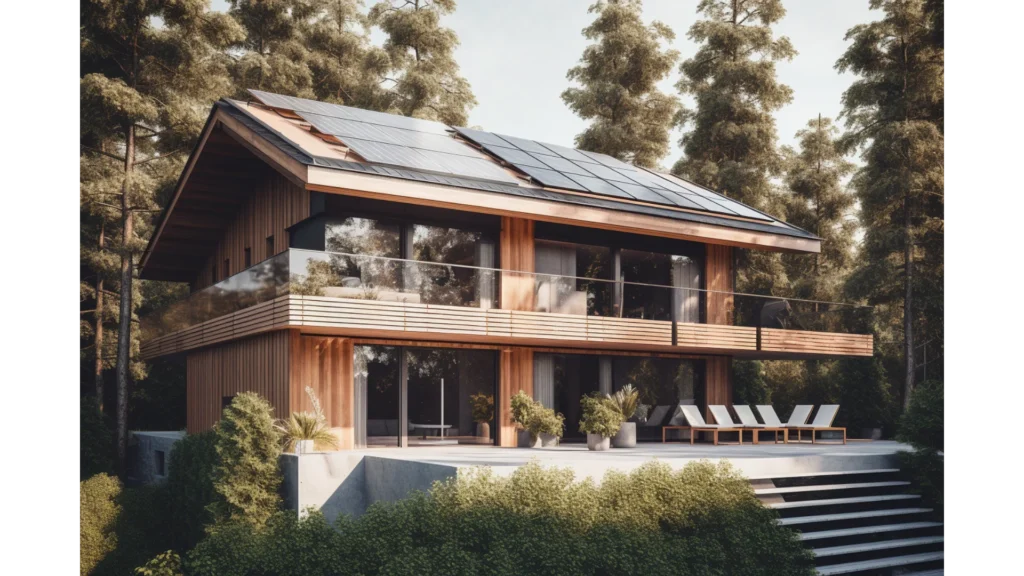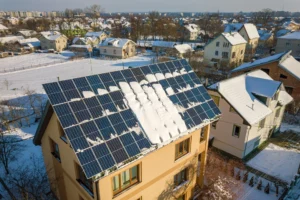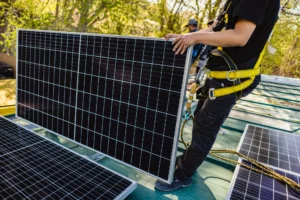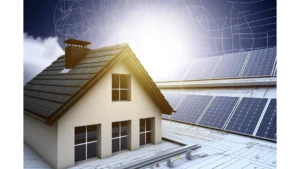
Solar power has become an increasingly popular alternative to traditional energy sources as people seek more sustainable, cost-effective ways to power their homes. While solar panels are commonly used for generating electricity, many homeowners wonder if they can also use solar energy for heating and cooling their homes. The answer is yes, but like most things related to renewable energy, it comes with some caveats.
This article will explore the possibilities and limitations of using solar power for home heating and cooling. We will delve into the science behind solar energy, explain how it can be harnessed for thermal purposes, and discuss the benefits and drawbacks of relying on this technology. By the end of this article, readers will clearly understand whether or not using solar energy for climate control is a viable option for their specific circumstances.
Understanding solar energy is crucial in determining its potential for residential applications. Solar energy is the radiant light and heat that comes from the sun, which humans have been harnessing for centuries. The advantages of using solar power are numerous. Solar panels generate electricity without emitting harmful greenhouse gases or pollutants into the atmosphere, making it a clean source of energy. Additionally, solar power is renewable and abundant, unlike non-renewable fossil fuels that will eventually run out.
Despite its numerous benefits, there are also some disadvantages to using solar power for heating and cooling homes. One disadvantage includes the initial cost of installing solar panels, which can be quite expensive upfront. However, over time, homeowners can save money on their electricity bills as they rely less on traditional sources of energy. Another limitation is that solar panels require ample sunlight to function effectively; thus, they may not be suitable for areas with minimal sunshine.
Overall, understanding how solar energy works is critical when considering its potential use in residential applications such as heating and cooling homes. While there are certain disadvantages to consider, such as installation costs and reliance on adequate sunlight availability, the advantages far outweigh them in terms of sustainability and reduced environmental impact. As technology continues to improve efficiency rates and reduce installation costs over time, we can expect greater adoption of this renewable source of energy in households around the world without any significant drawbacks or limitations.
Achieving a sustainable and efficient method of warming your household without relying on traditional energy sources can be accomplished by harnessing the power of the sun through solar energy. A home that is heated with solar power uses solar panels to collect sunlight and convert it into heat that can be used to warm the air or water in your home. The key to effectively using solar energy for heating is the proper placement of solar panels, which should be installed on south-facing roofs or walls that receive direct sunlight for most of the day.
Solar panels collect sunlight and convert it into heat, which can then be used to warm up rooms in your house. One popular way to use this technology is through radiant floor heating, where pipes are installed beneath your floors to circulate hot water. This alternative heating method works well with solar because it requires lower temperatures than traditional radiators or baseboard heaters, reducing the amount of energy needed from non-renewable sources.
In addition, there are other alternative heating methods that work well with solar energy, such as a geothermal system that relies on underground temperatures instead of outdoor temperature fluctuations. These systems work by circulating water through pipes buried deep underground, where temperatures remain constant throughout the year regardless of weather patterns above ground. The hot water produced by these systems can then be circulated throughout your home using a hydronic system.
Overall, incorporating solar energy into your home’s heating system provides an effective and environmentally friendly way to reduce reliance on traditional fossil fuels while also saving money over time. With proper placement of your solar panels combined with alternative heating methods like radiant floor heating or geothermal systems, you can achieve a comfortable living space without sacrificing efficiency or sustainability in the process.
Harnessing the sun’s energy for cooling your household is a sustainable and efficient method that can be achieved by properly placing solar panels and alternative cooling methods. Passive cooling techniques are an excellent way to reduce the need for air conditioning while keeping your home comfortable during hot weather. These techniques include shading, ventilation, insulation, and evaporative cooling. Implementing these methods can significantly decrease your electricity bill and environmental impact.
Solar air conditioning is another method that utilizes solar power to cool your home. This system works by using photovoltaic cells to generate electricity, which powers an air conditioner. Solar air conditioning units use less energy than traditional ones because they do not require grid power to run. They are also more environmentally friendly as they emit fewer greenhouse gases.
Installing solar panels on your home’s roof can provide enough energy to effectively run both passive cooling systems and solar air conditioning units. Proper placement of the panels is crucial in maximizing energy production throughout the day. South-facing roofs receive the most sunlight during peak hours, making them ideal for solar panel installation.
In conclusion, utilizing solar power to cool your home is a sustainable and efficient method that reduces energy consumption and environmental impact. Passive cooling techniques such as shading, ventilation, insulation, and evaporative cooling provide effective ways to keep your space cool without relying on traditional air conditioning systems. Meanwhile, solar air conditioning units offer a solution that uses clean energy sources while providing similar results to conventional AC units. With proper installation techniques, such as south-facing roofs with adequate panel coverage, homeowners can enjoy an eco-friendly lifestyle while saving money on their utility bills in the long run.
Utilizing solar energy as a primary source of power offers numerous benefits. One of the most significant advantages is cost savings, as solar panels require minimal maintenance and can significantly reduce electricity bills over time. Additionally, solar energy helps to reduce our carbon footprint by reducing reliance on fossil fuels, which contribute to greenhouse gas emissions. Lastly, solar energy allows for greater energy independence, ensuring access to reliable and sustainable power even during emergencies or power outages.
The implementation of solar energy as a source of temperature control presents a compelling case for cost savings. The initial investment in solar panels and equipment may seem steep, but an ROI analysis shows that the long-term savings are significant. Utility bills can be unpredictable and costly with traditional heating and cooling methods. However, with solar power, homeowners can benefit from consistent energy prices that reduce their monthly expenses.
In addition to saving money on utility bills, investing in solar power also increases the value of a home. A study conducted by the National Renewable Energy Laboratory found that homes with solar panels sold for 20% more than comparable homes without them. This means that homeowners not only save money on energy costs but also gain equity in their property over time. Overall, the cost savings associated with using solar power for heating and cooling make it an attractive option for those seeking financial freedom while reducing their carbon footprint.
Adopting solar energy for temperature control can significantly reduce carbon footprint, making it a viable option for individuals seeking to minimize their environmental impact. There are various methods for measuring and analyzing the reduced carbon footprint resulting from the use of solar power in heating and cooling homes. One such method is life cycle assessment (LCA), which evaluates the environmental impacts of a product or service throughout its entire life cycle, from raw material extraction to disposal.
According to studies, using solar-powered heating and cooling systems can significantly reduce greenhouse gas emissions compared to conventional systems powered by fossil fuels. However, it is important to consider both the pros and cons of reduced carbon footprint initiatives. While reducing one’s carbon footprint through renewable energy sources like solar power is beneficial for the environment, it may also come with certain drawbacks, such as higher upfront costs and potential system maintenance issues. Nonetheless, if implemented correctly, adopting solar power for temperature control can ultimately lead to a more sustainable future while providing cost savings over time.
Achieving energy independence through sustainable practices promotes a sense of empowerment and responsibility toward reducing our reliance on non-renewable resources. Homeowners who have installed solar panels for electricity generation are already taking a step towards self-sufficiency while contributing to the reduction of their carbon footprint. However, homeowners can take it one step further by using solar power for heating and cooling purposes as well.
The use of renewable energy sources such as solar power can provide homeowners with an alternative to traditional forms of heating and cooling that rely on non-renewable fossil fuels. Investing in solar thermal systems allows homes to be heated more efficiently during colder months without relying on natural gas or oil-fired furnaces. Similarly, during warmer months, air conditioning systems can be powered by solar panels instead of relying on grid electricity generated from coal-fired power plants. This reduces carbon emissions and gives homeowners greater control over their energy consumption and costs. The move towards self-sufficiency through renewable energy sources is a responsible approach towards environmental sustainability and personal freedom.
It is important to recognize the limitations of relying solely on solar energy for residential heating and cooling, as factors such as weather patterns and geographic location can greatly impact its efficiency. While solar power has numerous advantages, there are also some disadvantages that need to be considered before deciding to use it for home climate control.
Firstly, the amount of sunlight available in a given area plays a significant role in determining the effectiveness of solar panels. Cloudy or overcast days reduce the amount of energy solar panels generate, limiting their ability to provide consistent heating or cooling. Moreover, seasonal changes also affect how much sunlight is available throughout the year, which means that homeowners might not be able to rely on solar energy alone during certain times.
Secondly, installing a complete HVAC system powered by solar requires additional equipment and higher initial investment costs than traditional systems. This might make it challenging for some homeowners who do not have access to financing options or upfront capital. Additionally, regular maintenance and cleaning are necessary for optimal performance.
Lastly, reliance on batteries for storage during low-sunlight periods adds another layer of expense and complexity. Batteries require regular replacement and can add significantly to the cost of installation. Furthermore, battery technology may not be advanced enough yet to store enough energy economically.
In conclusion, while using solar power as an alternative source of energy has many benefits in terms of environmental sustainability and independence from fossil fuels sources; however, there are still several drawbacks associated with using it exclusively for household heating and cooling purposes. These include reduced efficiency due to weather patterns or geographic location; higher upfront costs; additional equipment required; regular maintenance needs; reliance on batteries during periods when sunlight is unavailable or insufficiently strong. Despite these challenges, solar power remains an excellent option for reducing greenhouse gas emissions and protecting our environment while providing sustainable energy solutions worldwide today!
Selecting an appropriate HVAC system for residential climate control requires careful consideration of various factors, including energy efficiency, cost-effectiveness, and environmental impact. When it comes to choosing the right heating and cooling system that utilizes solar power, there are a few types of systems that you can choose from. The most popular options are active solar heating and cooling systems, passive solar design strategies, and hybrid systems that combine both methods.
Active solar heating and cooling systems use mechanical equipment to move air or fluid through collectors that absorb sunlight and transfer heat into your home. These systems require a larger investment upfront but offer significant long-term savings on energy bills. On the other hand, passive solar design strategies rely on natural elements such as orientation, insulation materials, thermal mass, and shading devices to regulate indoor temperatures without any mechanical intervention. This option is more affordable but may not be suitable for all climates.
Sizing considerations play a crucial role in selecting the right system for your needs. Factors such as the location size of your home or business space determine how much energy you need to produce to meet your needs adequately. Oversizing or under sizing can lead to inefficient operation and higher costs in maintenance or replacement expenses in the future.
In conclusion, choosing the right HVAC system for heating and cooling with solar power requires careful evaluation of different aspects, such as the type of system (active vs. passive vs. hybrid), and sizing considerations based on location and building size. With proper planning and installation by qualified professionals who understand these factors well enough can help you achieve maximum energy efficiency while reducing costs on bills over time compared with traditional fossil fuel-based alternatives.
The next phase of the process involves installing and maintaining the chosen HVAC system, which requires careful attention to detail and regular upkeep to ensure optimal performance. When it comes to installing a solar-powered heating and cooling system, there are several tips that can help ensure its successful implementation. These include selecting a qualified installer who has experience with solar technology, obtaining all necessary permits, ensuring proper placement of panels for maximum sun exposure, and testing the system thoroughly before use.
Once installed, maintaining a solar-powered HVAC system is crucial for its long-term efficiency and effectiveness. A maintenance checklist should include regular cleaning of the solar panels to remove any debris or dust that may accumulate over time, as this can significantly reduce their energy output. Additionally, checking for leaks or damage in pipes and ducts is essential to prevent heat loss or air leakage that can waste energy unnecessarily. Regular inspections by a qualified technician can also help identify any potential issues early on before they become major problems.
In addition to standard maintenance practices, homeowners may also want to consider implementing additional strategies to maximize their system’s effectiveness. For instance, using ceiling fans in conjunction with an HVAC system can help circulate cooled or heated air throughout the home more efficiently and effectively. Likewise, adding insulation in key areas such as attics or crawl spaces can help minimize heat loss during colder months while keeping homes cooler during warmer months.
Overall, installing and maintaining a solar-powered HVAC system requires careful consideration of several factors, including choosing a qualified installer, proper placement of panels for optimal sun exposure, and regular inspection and cleaning protocols for maximum efficiency over time. By following these guidelines and other best practices like using ceiling fans or insulation where possible, homeowners can enjoy clean energy savings year-round without sacrificing comfort levels!
This section focuses on the financial and incentive aspects of implementing an HVAC system, which can be a crucial component in making the decision to invest in this technology. When it comes to financing a solar-powered HVAC system, homeowners have several options available. One of the most popular ways is through solar panel financing, where loans are provided specifically for installing solar panels. These loans typically come with low-interest rates and flexible repayment terms.
Another option for financing is through government subsidies. In many countries, governments offer incentives to encourage the adoption of renewable energy sources such as solar power. These incentives include tax credits, rebates, and grants that can significantly reduce the cost of installation while also providing long-term savings on energy bills.
To provide further insight into these financial options for homeowners considering a solar-powered HVAC system, we have created a table below outlining some key information about each option:
Financing Option | Description | Pros | Cons |
|
|
|
|
Solar Panel Financing | Loans designed specifically for solar panel installation with low-interest rates and flexible repayment terms. | Easy access to funds; Low-interest rates; Flexible repayment terms; Increased home value due to investment in renewable energy. | It may require a good credit score or a higher down payment; Monthly payments may be added to existing utility bills. |
Government Subsidies | Tax credits, rebates, or grants are offered by governments to incentivize the adoption of renewable energy sources like solar power.| | Reduced upfront costs; Long-term savings on energy bills; Positive environmental impact. | Eligibility requirements may vary based on location or income level. |
In conclusion, when it comes to financing a solar-powered HVAC system for your home heating and cooling needs, there are several options available, including solar panel financing and government subsidies. It is important to consider all financial options before making a decision as they can significantly reduce upfront costs while also providing long-term benefits such as increased home value and lower energy bills. With the increasing popularity of renewable energy sources, homeowners can take advantage of these incentives to invest in a more sustainable and cost-effective future.
This paper has highlighted the benefits of solar power as a renewable and sustainable energy source for households. The key points discussed include the various types of solar panels, financing and incentives available, and their potential for heating and cooling homes. To take action towards switching to solar energy, individuals can consult with professionals in the industry or research further resources available online. For those interested in learning more about solar power, numerous educational materials and organizations are dedicated to promoting its use.
The Summary of Key Points presents a concise overview of the main ideas and concepts related to utilizing solar energy for residential temperature regulation. Solar power has several benefits when used for heating and cooling homes, including cost savings on utility bills, reduced carbon footprint, and increased energy independence. However, there are also some drawbacks to consider, such as initial installation costs and the need for backup systems during times of low sunlight.
System design is essential to consider when using solar power for home temperature regulation. The system should be designed based on each household’s unique needs, considering factors such as location, climate, and seasonal changes in sunlight availability. Proper insulation and ventilation are also crucial to maximize efficiency and reduce energy waste. With proper planning and implementation of a solar-powered heating and cooling system, homeowners can significantly reduce their reliance on traditional energy sources while enjoying a comfortable living environment.
Adopting a solar-powered system for residential temperature regulation requires careful consideration of several factors. Finding incentives and researching options can help homeowners make the best choice for their individual needs. Incentives, such as tax credits or rebates, are available in many areas to help offset the initial cost of installing solar panels. Researching companies that specialize in solar installation is crucial to ensure quality workmanship and efficient performance.
In addition to finding incentives and researching options, it’s essential to consider the location and climate of your home when switching to a solar-powered system for heating and cooling. Some locations may not have enough sunlight year-round, making achieving maximum efficiency from a solar power system difficult. Additionally, seasonal changes must be taken into account when calculating energy needs throughout the year. By carefully considering these factors before making the switch, homeowners can ensure minimal energy waste and maximum savings on their energy bills over time.
To continue our discussion on switching to solar energy, it is important to consider the resources available for further information. While taking action towards a more sustainable lifestyle through solar power can be daunting, there are many resources available to help make the process smoother and more manageable. One of the most important steps in transitioning to solar power is finding reliable installers who can guide homeowners through the installation process and ensure that their systems are working efficiently.
In addition to finding installers, evaluating system performance is crucial in maximizing solar energy’s benefits. This involves monitoring energy production and usage patterns and identifying any potential issues with equipment or maintenance needs. To aid in this process, various software tools are available that can track system performance and provide valuable insights into how homeowners can optimize their solar power usage. Utilizing these resources can ultimately help homeowners achieve greater energy independence and reduce their carbon footprint while enjoying long-term cost savings.
Solar energy has become an increasingly popular source of renewable energy for residential homes. It is a clean and sustainable source of power that can be used for various applications, including heating and cooling. While solar energy may not be suitable for every home or situation, it can offer numerous benefits when used correctly.
When considering using solar energy to heat or cool your home, it is important to understand the technology behind it. Solar thermal systems use sunlight to heat water or air, which can then be used to provide warmth during colder months. On the other hand, solar-powered air conditioning systems use photovoltaic cells to convert sunlight into electricity that powers the unit’s compressor and fan motors.
Using solar energy for heating and cooling can help reduce your carbon footprint while also saving money on utility bills. Additionally, this type of system requires little maintenance once installed properly. However, some limitations exist, such as location (solar panels work best in areas with plenty of sunshine) and cost (installation can be expensive).
To choose the right system for your home, you must first determine your specific needs and expectations regarding heating and cooling. You should also research available financing options and incentives offered by government programs or local utilities. Installing a solar-powered heating or cooling system requires professional expertise; therefore, hiring certified installers is crucial.
In conclusion, using solar power for heating and cooling your home is an excellent way to reduce reliance on fossil fuels while taking advantage of a free natural resource: sunlight. Despite some limitations, such as installation costs and regional factors affecting efficiency rates, this type of setup offers many benefits in reducing carbon emissions and lowering utility bills over time. By researching options carefully before making any decisions about investing in such an alternative energy source like solar power, homeowners will have all the necessary information needed at their fingertips so they can make informed choices based on their individual needs!
Passive and active solar heating and cooling systems differ in their approach to harnessing the sun’s energy for temperature regulation. Passive systems rely on natural means of heat exchange, such as convection, radiation, and absorption via building materials. On the other hand, active systems employ mechanical devices like pumps or fans to circulate air or fluids through collectors that absorb solar radiation. While both types of systems offer potential benefits in terms of reducing energy consumption and greenhouse gas emissions compared to traditional heating and cooling methods, their efficiency depends on factors such as climate conditions, building design, orientation, shading, and insulation. Optimization strategies may include incorporating thermal mass into structures to store excess heat or coldness or using computer-controlled sensors to adjust system operation based on real-time data. Ultimately, achieving maximum solar heating and cooling efficiency requires a comprehensive analysis of various variables specific to each case.
Maximizing the efficiency of solar heating and cooling systems involves implementing a variety of techniques. Insulation methods, such as adding weatherstripping and sealing air leaks, can help reduce energy loss. Smart thermostats, which allow for remote temperature control and learning algorithms to adjust based on usage patterns, can also improve efficiency. Geothermal options provide another avenue for maximizing solar heating potential by utilizing the earth’s constant temperature to heat or cool a home. Radiant floor systems can distribute heat evenly throughout a room without relying on air circulation. By incorporating these techniques into a solar heating and cooling system, homeowners can increase efficiency and reduce their reliance on traditional energy sources while enjoying greater comfort in their homes.
Permit requirements and cost analysis are important factors to consider when installing a solar heating and cooling system in your home. Depending on your location, government regulations or permits may be required to install such systems. These regulations vary by country, state, and even city. It is essential to research the specific permit requirements for your area before beginning any installation process. Additionally, it is crucial to perform a comprehensive cost analysis to determine if the investment in a solar heating and cooling system is worth it in terms of long-term energy savings versus upfront costs. This analysis should include the initial purchase price, ongoing maintenance expenses, and potential tax incentives or rebates that can offset some of these costs over time. By carefully considering both permit requirements and cost analysis, homeowners can make informed decisions about whether or not installing a solar heating and cooling system is right for their needs.
Integration options and cost-effectiveness are two important considerations when considering the use of a solar heating and cooling system in conjunction with a traditional HVAC system. Multiple integration options are available, including using the solar system as a supplement to the traditional HVAC system or as the primary source of heating and cooling with backup from the traditional system. The cost-effectiveness of this integration largely depends on factors such as geographic location, energy needs, and installation costs. It is important to consult with professionals who can assess these factors in order to determine whether integrating a solar heating and cooling system is a viable option for your specific situation. In general, however, utilizing renewable energy sources such as solar power can offer significant long-term savings on energy bills while also reducing environmental impact.
Solar heating and cooling systems have become increasingly popular as an environmentally friendly and cost-effective alternative to traditional HVAC systems. The lifespan of a solar heating and cooling system depends on various factors, including the quality of equipment used, maintenance requirements, and climate conditions. Proper maintenance is crucial to ensure optimal performance and longevity of the system, which may include cleaning panels, checking for leaks in pipes or ductwork, replacing filters, and testing backup heating options. While installation costs can be high initially, energy savings over time can offset these costs depending on local energy rates and financing options. Solar thermal systems are typically more efficient for space heating applications, while photovoltaic systems are better suited for electricity generation with potential excess power sold back to the grid. The environmental impact of solar energy is minimal compared to fossil fuel-based alternatives. In summary, solar heating and cooling systems offer a promising solution for reducing carbon emissions while providing long-term benefits in terms of economic savings and increased energy independence.

How much Electricity does Solar generate in Winter Months? Share: Facebook Twitter LinkedIn Pinterest How much Electricity does Solar generate in Winter ? Solar energy

How Does The Efficiency Of Solar Panels Change Over Time? Share: Facebook Twitter LinkedIn Pinterest Solar energy has become an increasingly popular renewable energy source

How Do I Compare The Performance And Efficiency Of Different Solar Panel Brands And Models? Share: Facebook Twitter LinkedIn Pinterest Solar energy is an increasingly

Will I Still Have Electricity During A Power Outage If I Have Solar Panels? Share: Facebook Twitter LinkedIn Pinterest During natural disasters or other emergency

Efficiency Of Residential Solar Systems Share: Facebook Twitter LinkedIn Pinterest Residential solar systems have become increasingly popular as homeowners look for ways to generate their